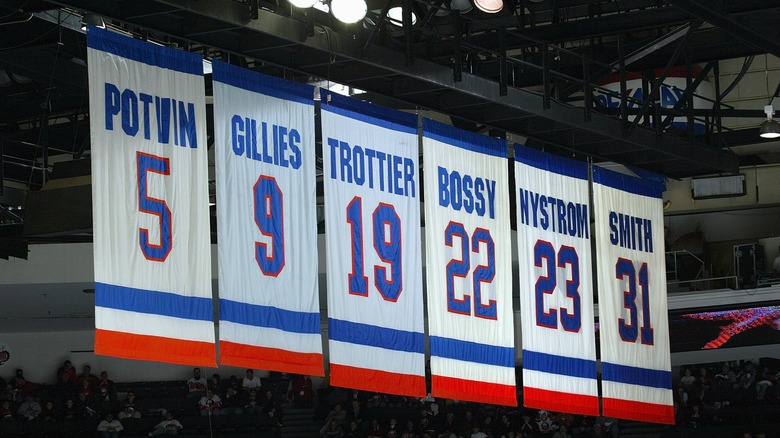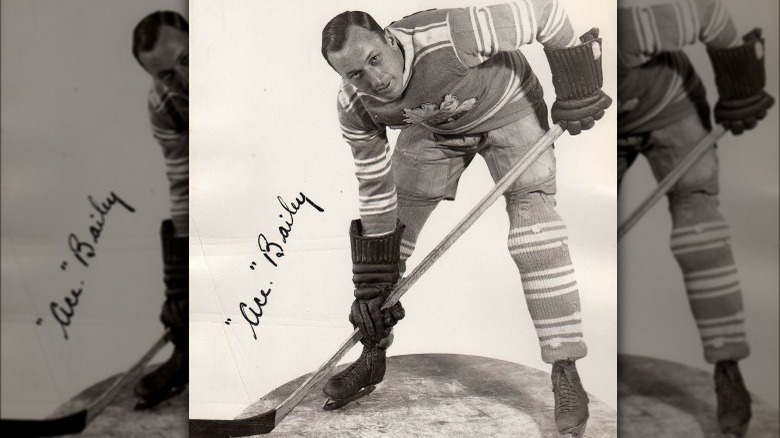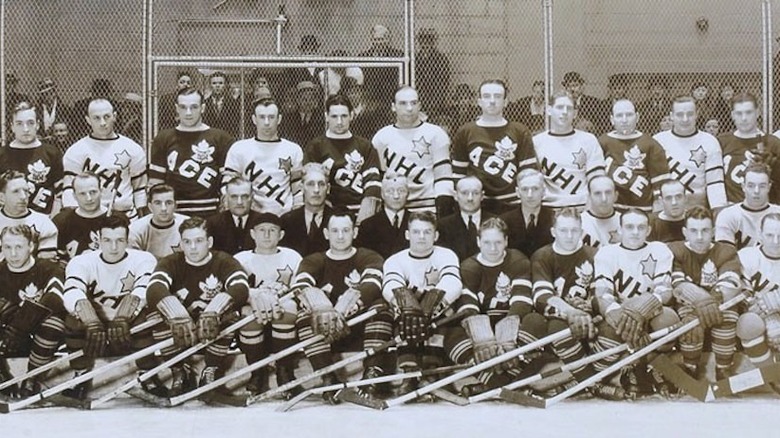You'll Never Guess What The Very First Retired Professional Sports Number Was
Today it is very common to see retired numbers hanging in the rafters of your favorite team's stadium. Some teams with long histories have a long list of retired numbers. The Boston Celtics, with 23 retired numbers (via Celtics Wire), and the New York Yankees, with 22 retired numbers (via MLB), currently have the most. Other teams have none. The Miami Marlins, who have been an MLB team for less than 30 years, haven't had a player earn that honor yet (via MLB). The Dallas Cowboys, on the other hand, do have a storied history, yet they have traditionally chosen not to retire any numbers (via ESPN).
Some players are even honored with a league-wide retirement of their number because of their contribution to the sport. Jackie Robinson's number 42, Wayne Gretzky's number 99 and most recently Bill Russell's number 6 have all received that rare distinction. But to know how and why this tradition started, you have to go all the way back to 1934 and the Toronto Maple Leafs (via The Hockey Writers).
An early retirement
Irvine "Ace" Bailey began playing for the Toronto Maple Leafs in the 1926-27 season when he tallied 15 goals and 13 assists in 42 games played (via Hockey DB). He quickly became one of the top players for the Maple Leafs, leading them in scoring in both the 1928-29 and 1929-30 seasons as well as scoring the game-winning goal in the 1932 Stanley Cup finals (via The Hockey Writers).
Bailey's career continued on successfully until part-way through his eighth season for the Maple Leafs. In a December 1933 game against the Boston Bruins, Bailey's career was cut short following a hit he received from Bruins' defenseman Eddie Shore (via The Hockey Writers). Helmets weren't required to be worn by the NHL until the 1979-80 season (via ESPN), so a helmetless Bailey fractured his skull after hitting the ice following the Shore check. On top of the skull fracture, Bailey suffered a cerebral hemorrhage and fell into a coma for 10 days, according to the Toronto Star. Bailey did eventually make a full recovery. However, the tragic injuries were so severe that he was never able to play hockey again. A few months after Bailey's final game the Maple Leafs found a way to honor him.
The start of a tradition
In February 1934, the Maple Leafs hosted an exhibition game between themselves and a team of NHL All-Stars to benefit Bailey and raise money for his family. According to The Hockey Writers, the game raised over $20,000, and also served as the precursor to the NHL All-Star game tradition that started 13 years later.
It was at this game, in front of a standing room only crowd of 14,074 (via Last Word on Sports), that Maple Leafs legendary coach Conn Smythe declared that no Maple Leafs player would wear Bailey's number 6 again. And thus the tradition of retiring player's numbers in sports was born. Bailey, despite never playing another game, was an active member of the Maple Leafs organization until 1984, working as a timekeeper (via The Hockey Writers), and was elected into the Hockey Hall of Fame in 1975. Even though Bailey had a very successful playing and post-playing career in the NHL, his biggest impact on the world of sports was having the honor of being the first retired number. This began a tradition beloved by players and fans alike that continues to this day.


